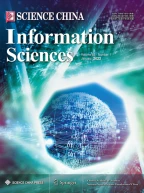Abstract
Side channel analysis(SCA) focuses on attacking cryptographic algorithm implementations by collecting leaked information and analyzing the correlation between the leaked and key information in the cryptographic system. Currently, SCA is the main threat to cryptographic implementations, with DPA (differential power analysis) and DFA (differential fault analysis) being two of the most threatening types of SCA. However, the existing countermeasures against DPA and DFA have shortcomings and can hardly protect cipher designs perfectly. Based on a comprehensive analysis of DPA and DFA, this paper proposes a new idea of using an evolutionary cipher (EVOC) against DPAs based on the model proposed by Kocher, and several different new types of DFAs. In fact, an EVOC is a kind of dynamic cipher designing method. Moreover, combined with intelligent searching algorithms and cryptography design policies, EVOCs utilize the dynamic and unpredictable properties of TRNG (a truly random number generator) to ensure cipher design at a high level of security. Therefore, with an EVOC we could design cryptography algorithms with high security to resist mathematical analysis as well as DPAs and DFAs. This paper analyzes and proves the security, efficiency, cost, and original features of EVOCs against DPA and DFA both theoretically and experimentally. Compared with existing countermeasures against SCAs, EVOCs use dynamic non-linear operations to destroy the bases of DPA and DFA. At the algorithm level, EVOCs are more efficient than other resistance methods. Based on the theory and experiments, this paper proposes certain modifications to the EVOC in the AES (advanced encryption standard) algorithm, which can be referenced by other dynamic designs of cryptographic algorithms.
Similar content being viewed by others
References
Kocher P. Timing attacks on implementations of Diffie-Hellman, RSA, DSS, and other systems. In: Proceedings of the 16th Annual International Conference on Advances in Cryptology, Saragossa, 1996. 104–113
Kocher P, Jaffe J, Jun B. Differential power analysis. In: CRYPTO 1999, Santa Barbara, 1999. 388–397
Trichina E, Seta D D, Germani L. Simplified adaptive multiplicative masking for AES. In: Workshop on Cryptographic Hardware and Embedded Systems (CHES 2002), San Francisco, 2002. 187–197
Tiri K, Hwang D, Hodjat A, et a1. AES-based cryptographic and biometric security coprocessor IC in 0.18 μm CMOS resistant to side channel power analysis attacks. IEEE J Solid-State Circuit, 2006, 41: 781–792
Suzuki D, Saeki M, Ichikawa T. DPA leakage models CMOS logic circuits. In: Workshop on Cryptographic Hardware and Embedded Systems 2005 (CHES 2005), Edinburgh, 2005. 366–382
Mentens N, Gierlichs B, Verbauwhede I. Power and fault analysis resistance in hardware through Dynamic reconfiguration. In: Workshop on Cryptographic Hardware and Embedded Systems 2008 (CHES 2008), Washington, 2008. 346–362
Yang S, Wolf W, Vijaykrishnan N, et a1. Power attack resistant cryptosystem design: a dynamic voltage and frequency switching approach. In: 2005 Design, Automation and Test in Europe Conference and Exposition (DATE 2005), Munich, 2005. 64–69
Boneh D, DeMillo R A, Lipton R J. On the importance of checking cryptographic protocols for faults. In: EUROCRYPT 1997, Konstanz, 1997. 37–51
Blomer J, Seifert J P. Fault based cryptanalysis of the advanced encryption standard (AES). In: Financial Cryptography 2003, Guadeloupe, 2003. 162–181
Dusart P, Letourneux G, Vivolo O. Differential fault analysis on AES. January 20 2003. Available from: http://eprint.iacr.org/~2003/010
Piret G, Quisquater J J. A differential fault attack technique against SPN structures, with application to the AES and KHAZAD. In: CHES 2003, Cologne, 2003. LNCS 2779. 77–88
Moradi A, Shalmani M T M, Salmasizadeh M. A generalized method of di?erential fault attack against AES cryptosystem. In: Workshop on Cryptographic Hardware and Embedded Systems (CHES 2006), Yokohama, 2006. LNCS 4249. 91–100
Tiri K, Verbauwhede I. A digital design flow for secure integrated circuits. IEEE Trans Comput-Aided Des Integr Circuits Syst, 2006, 25: 1197–1208
Zhang H G, Feng X T, Qin Z P, et al. Research on evolutionary cryptosystems and evolutionary DES. Chin J Comput, 2003, 26: 1678–1684
Song J, Zhang H G, Meng Q S, et al. Cryptanalysis of four-round DES based on genetic algorithm. In: Wireless Communications, Networking and Mobile Computing (WICOM 2007), Shanghai, 2007. 2326–2329
Wang C, Zhu M L. Design of algorithm for selecting secure ECC based on ant colony. J Wuhan Univ, 2008, 54: 540–542
Tang M, Meng Q S, Zhang H G. Evolutionary design of trace form bent function. 24 Sep 2005. Available from: http://eprint.iacr.org/2005/322
Meng Q S, Zhang H G, Tang M, et al. Analysis of affinely equivalent Boolean functions. Sci China Ser F-Inf Sci, 2007, 50: 299–306
Xilinx. OPB HWICAP. Available from: http://www.xilinx.com/bvdocs/ipcenter/datasheet/opbhwicap.pdf
Zhang H G, Li C L, Tang M. Capability of evolutionary cryptosystems against differential cryptanalysis. Sci China Inf Sci, 2011, 54: 1991–2000
Schneier B. Applied Cryptography. New Jersey: John Wiley & Sons, 1996
Quisquater J J, Samyde D. Electromagnetic analysis (EMA): measures and countermeasures for smart cards. In: E-SMART’ 01, Cannes, 2001. 200–210
Akkar M, Giraud C. An implementation of DES and AES secure against some attacks. In: Workshop on Cryptographic Hardware and Embedded Systems (CHES 2001), Paris, 2001. 309–318
Golic J D, Tymen C. Multiplicative masking and power analysis of AES. In: Workshop on Cryptographic Hardware and Embedded Systems (CHES 2002), San Francisco, 2002. 198–212
Prouff E. DPA attacks and S-BOXes. In: Fast Software Encryption 2005 (FSE 2005), Paris, 2005. 424–441
Karri R, Kuznetsov G, Goessel M. Parity-based concurrent error detection of substitution — permutation network block ciphers. In: Workshop on Cryptographic Hardware and Embedded Systems 2003 (CHES 2003), Cologne, 2003. 113–124
Yen C, Wu B. Simple error detection methods for hardware implementation of advanced encryption standard. IEEE Trans Comput, 2006, 55: 720–731
Schneier B, Kelsey J, Whiting D, et al. The Twofish Encryption Algorithm: A 128-Bit Block Cipher. Michigan: John Wiley & Sons, Inc, 1999
Author information
Authors and Affiliations
Corresponding author
Rights and permissions
About this article
Cite this article
Tang, M., Qiu, Z., Yang, M. et al. Evolutionary ciphers against differential power analysis and differential fault analysis. Sci. China Inf. Sci. 55, 2555–2569 (2012). https://doi.org/10.1007/s11432-012-4615-6
Received:
Accepted:
Published:
Issue Date:
DOI: https://doi.org/10.1007/s11432-012-4615-6
